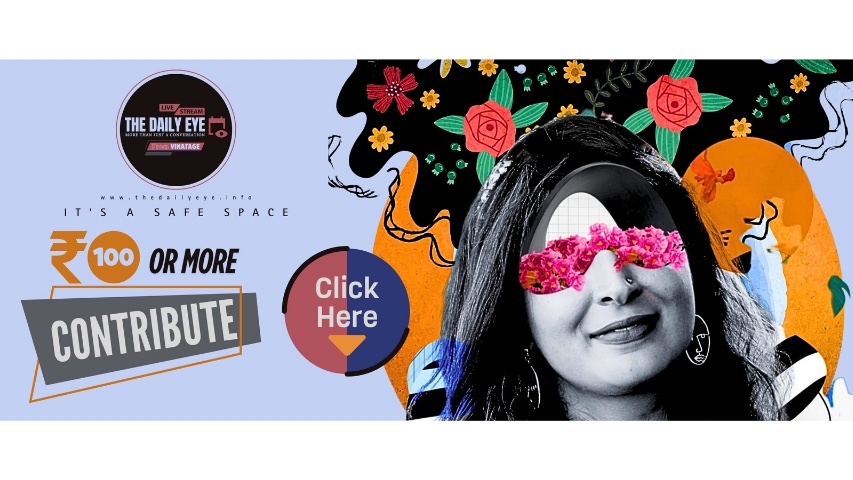
FESTIVALS: CINEMA ENDURES BECAUSE ARTISTS PERSIST
by Arnab Banerjee November 16 2025, 12:00 am Estimated Reading Time: 9 mins, 14 secsA powerful three-day gathering in New Delhi explored cinema’s endurance against censorship, showcasing suppressed films, bold conversations, and underground screenings that reaffirmed art’s unshakeable ability to create dialogue, and inspire resistance across generations. By: Arnab Banerjee.
And Cinema Goes On Undeterred – A Three-Day Film Festival
10–12 October | NIV Art Centre, New Delhi
The three-day film festival And Cinema Goes On at NIV Art Centre, New Delhi, brought together filmmakers, scholars, critics, students, and cinephiles to explore cinema’s enduring power in times of censorship, crisis, and political pressure. With rare screenings, underground favourites, panel discussions, and workshops by celebrated voices such as Dibakar Banerjee, Saibal Chatterjee, and Shuddhabrata Sengupta, the festival highlighted how films suppressed or silenced often return with even greater cultural force. Reflecting global and Indian histories of cinematic resistance—from Kiarostami and Panahi to Bandit Queen and Fire—the event positioned cinema as an unstoppable medium of truth and hope. Designed to resonate across search engines and social platforms, this narrative reinforces the urgency of artistic freedom and the timeless resilience of filmmakers who refuse to be muted.
At the three-day film festival And Cinema Goes On, held earlier this month at the NIV Art Centre in New Delhi, the curator’s note set the tone. The idea was simple yet subversive: to showcase films that had faced suppression, and to discuss, through them, the endurance of cinema itself. Over three days, screenings, workshops, and conversations brought together filmmakers, scholars, critics, and students to reflect on the role of cinema in times of crisis—both political and moral.
A Festival Born from Ruins
The festival drew inspiration from Abbas Kiarostami’s And Life Goes On (1992), a quietly profound film set in post-earthquake Iran. In 1990, Kiarostami travelled to the ruined village of Koker with his camera, capturing not devastation, but resilience. His lens found life among the rubble. That film became the festival’s starting point and its metaphor.
How do artists continue to create in lifeless times? How does one celebrate hope when surrounded by hopelessness? These questions, posed by Kiarostami’s film, formed the heart of the festival’s inquiry. As curator Labanya Dey noted in her statement, the festival was “about cinema that refuses to die, and artists who refuse to be silenced.”
Day One: Frames of Resistance
The opening day featured three screenings: And Life Goes On (1992) by Abbas Kiarostami, This Is Not a Film (2011) by Jafar Panahi, and No Other Land (2024) by Basel Adra, Hamdan Ballal, Yuval Abraham, and Rachel Szor. Each film dealt with resilience in the face of suppression—whether in Iran or Palestine.
The post-screening discussion, led by Shuddhabrata Sengupta, explored the politics of Palestinian cinema, where storytelling itself becomes an act of protest. The conversation ranged from the ethics of representation to the idea of the filmmaker as a witness—one who refuses to look away.
Day Two: Filmmaking and Staying Alive
The second day saw an eager audience spilling out onto the terrace and stairways of NIV Art Centre, where even the floor became a seat. The highlight was LSD 2 (2024), followed by a workshop with filmmaker Dibakar Banerjee titled Filmmaking and Staying Alive. Later that evening, Jafar Panahi’s Closed Curtain (2013) played to a packed house.
Panahi’s film, made during his house arrest, mirrored the festival’s spirit. Shot in secrecy and smuggled out of Iran, it reflects on artistic imprisonment, both literal and psychological. For the young audience, many of whom had never seen Panahi’s work in theatres, the screening was not just an event but an awakening.

The Politics of Art and Dissent
Discussions throughout the festival returned to a central theme: the uneasy relationship between art and authority. “Art has always challenged the legitimacy of power,” said noted film critic Saibal Chatterjee during one of the panels. “Authoritarian regimes, being hypersensitive to dissent, often see honest art as subversion. That is why films, music, theatre, and literature are so often the first to be censored.”
Artistic Director Labanya Dey elaborated: “Censorship today wears different faces—it may come through funding cuts, digital takedowns, or economic coercion. But the intent is the same: to control narratives. Yet, artists adapt. They find new mediums, new codes of expression. Suppression only proves how powerful art truly is.”
Journalist and critic Faizal Khan added another dimension: “Art speaks to emotion, not ideology. It reaches where political speech cannot. That’s why governments fear it—it humanizes. Across history, protest posters, songs, and films have brought people together in ways official channels never could.”
Underground Screenings and the Streisand Effect
Many of the students attending And Cinema Goes On have been part of underground film clubs that screen banned or controversial films. Their defiance is both aesthetic and political—a rejection of censorship as an instrument of control. “Such screenings are more than rebellion,” said Chatterjee. “They are a survival strategy—a way to keep the conversation alive.”
Dey pointed to the “Streisand effect”—the irony that attempts to ban or hide a film often make it more famous. “Every time a work is censored, it becomes more visible. The controversy draws new audiences. Cinema, in that sense, always finds a way to continue.”
Global Echoes of Suppression
Around the world, films once banned or condemned have gone on to become legends. Stanley Kubrick’s A Clockwork Orange (1971) was withdrawn from UK cinemas after public outrage but gained mythic status in its absence.
Martin Scorsese’s The Last Temptation of Christ (1988) turned accusations of blasphemy into a debate on faith and freedom.
Sergei Eisenstein’s Battleship Potemkin (1925) was banned across nations for its revolutionary message yet became a cornerstone of modern cinema.
Even comedies like Monty Python’s Life of Brian (1979), denounced as blasphemous, and extreme works such as Pasolini’s Salò (1975) or Deodato’s Cannibal Holocaust (1980) gained cult status through controversy.
The Indian Story: Fire and Freedom
In India, too, controversy has often amplified the cultural reach of films.
Shekhar Kapur’s Bandit Queen (1994) faced court battles over its portrayal of Phoolan Devi but opened national conversations on representation and consent.
Deepa Mehta’s Fire (1996), attacked for depicting same-sex love, became a turning point in the country’s dialogue on sexuality and women’s rights.
More recently, Udta Punjab (2016) turned its fight with the Censor Board into a national debate on freedom of expression, eventually strengthening both its message and its audience.
A Cinema That Refuses to Die
As the festival ended, what lingered was not despair but determination. Cinema, the so-called “seventh art,” continues to evolve even within the tightest grip of authority. Whether filmed in secret, screened underground, or streamed across borders, its pulse endures.
In the closing words of the curator, “Every time a film is banned, another is born. Every time a voice is silenced, a lens begins to see. That is why, despite everything—cinema goes on.”

The Low-Key Elegy of a Grand Finale: A Whisper That Outshone the Roar
The final flourish on this bitter confection was meant to be Tees — Dibakar Banerjee’s much-awaited, never-seen fever dream of a film, now consigned to the shadows by the cowards of corporate censorship. Starring Manisha Koirala, Huma Qureshi, Shashank Arora, Naseeruddin Shah, Neeraj Kabi, Divya Dutta, Kalki Koechlin, and Zoya Hussain, Tees was conceived as a chronicle of a Kashmiri Muslim family stretched across time — from the turbulent 1980s to a dystopian 2042 — where memory itself becomes an act of rebellion.
It was not merely a film but a lament — an elegy woven with the threads of loss, exile, and unrelenting resistance. Through stories of fractured friendship and a queer lawyer’s quiet war against prejudice, Banerjee sculpted a mosaic of modern India’s moral decay.
But where lesser works merely flirt with politics, Tees dared to look the republic straight in the eye. It was a mirror too clear for comfort — a “scathing look at the idea of India,” dissecting its descent into majoritarian arrogance and manufactured amnesia. Banerjee’s genius lay in his restraint: his outrage whispered, never screamed. He captured the ache of displacement without resorting to slogan, the corrosion of conscience without sermon. The film mourned both Muslim marginalization and Pandit dispossession, recognizing in each the same wound — that of a nation steadily devouring its own children.
Structured as an anthology spanning three eras, Tees stitched together its tales with near-mystical precision — each scene haunted by echoes of the past, each silence trembling with what the future would become. It was cinema not just to be seen, but to be endured, revisited, and wrestled with.
And yet, despite being completed in 2022, Tees was locked away by Netflix — a platform that prides itself on “bravery,” but flinched at the first whiff of discomfort. Like a nervous bureaucrat shredding truth before it can be read, Netflix buried the film, fearing the inevitable outrage that greets any work daring to think.
Banerjee, ever defiant, took Tees underground — screening it at festivals, universities, and wherever art still breathes free. There, in dimly lit auditoriums and whispered conversations, it found new life as a forbidden relic — a testament to what remains of artistic courage in an era of algorithmic cowardice.
In the end, Tees is less an unreleased film than a haunting — a muted masterpiece whose silencing says more about India’s cultural present than any dialogue within it could. Its absence is a monument to the very fear it sought to expose.
What next?
Let us hope that such fearless ventures by this young curatorial team find the strength they deserve — full funding, wide viewership, and the unyielding courage to remind us what cinema can still be. A nation that refuses the chokehold of authoritarian will let its artists breathe, dream, and dissent. Only then can art flourish — uninterrupted, undeterred, unchained.
In this bleak theatre of our days—where hope limps and truth bleeds—poet-lyricist Sahir Ludhianvi’s searing words from Woh Subah Kabhi Toh Aayegi cut deeper than ever. And render even more poignant today. His verses - an anthem for all who bear life’s relentless trials, yet nurture within their hearts an unquenchable hope for a dawn brighter than the darkness of their present sorrows. They are not mere songs but wounds that sing, hymns forged from hunger and heartbreak. They rise still—ragged, defiant—as if faith itself were clawing its way out of despair’s grave. For those crushed beneath the weight of their own tomorrows, his voice remains a burning promise: that even through the ash and ruin, some merciful dawn must one day break






-173X130.jpg)


-173X130.jpg)

-173X130.jpg)